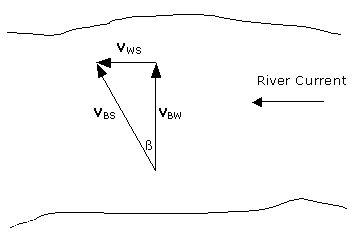Application Problems: Use of Addition Vector Tools to Solve Relative Velocity
Vector Problems, Example One.-
A motorboat velocity is 20 km/h in still water. If the boat must travel straight
to the nearest shore in a river whose current is 12 km/h, ¿What up stream
angle must the bow boat point at?

Before attempting to solve this problem, it
is useful to do some considerations:
- Whenever a velocity is mentioned, it is necessary to specify what is its
frame of reference to measure it. This is a case where we have relative velocities
and the tool to find the resultant or the components is the vector sum.
- It is helpful to use an identification procedure that uses two sub indexes:
the first sub index refers to the object and the second one to the frame of
reference in which that velocity is measured. In this example VBW
is the velocity of the Boat relative to the Water, VBS
is the Boat velocity relative to the Shore and VWS
is the Water velocity relative to the Shore. Notice VBW
is produced by the boat motor, instead VBS is VBW
plus the current effect. Hence, the boat velocity relative to the shore VBS,
is
(A) VBS = VBW + VWS
The sentence "a motorboat velocity is 20 km/h
in still water" means VBW = 20 km/h, and the sentence "a river
whose current is 12 km/h" means VWS = 12 km/h. Notice VBS
points directly straight to the opposite shore as wanted. The angle ![]() can be obtained from the rectangular triangle in the figure:
can be obtained from the rectangular triangle in the figure:
sen![]() = VWS/VBW
= 12/20 = 0.6 then
= VWS/VBW
= 12/20 = 0.6 then ![]() = 36.87º. The bow boat must point at an angle of 36.87º up stream in order
to cross the river directly to the other shore.
= 36.87º. The bow boat must point at an angle of 36.87º up stream in order
to cross the river directly to the other shore.
Vector Problems, Example 2.-
A boat velocity is 2 m/s in still water. a) If the boat points the bow straight
to the opposite shore to cross the river whose current is 1 m/s, what is the
velocity, in magnitude and direction, of the boat relative to the shore? b)
What is the boat position relative to its starting point, after 3 min?

a) The boat velocity relative to the shore VBS, is the sum of its velocity relative to the water VBW, and the water velocity relative to the shore VWS :
VBS = VBW + VWS
As VBW and VWS
are the sides of a rectangular triangle,
VBS2 = VBW2 + VWS2
or
VBS2 = (2m/s)2 + (1m/s)2 i.e.
VBS = 2.24 m/s.
Also, tan![]() = VWS/VBW
= 1/2 , then
= VWS/VBW
= 1/2 , then ![]() =
26.57º.
=
26.57º.
b) To calculate the position after 3 min we can use D = Vt, with D the vector displacement, V the vector velocity and t the time, an scalar. The direction of D is the same as V and its magnitude is V·t = 2.24 m/s·3·60 s = 403.2 m. The boat position is then at 403.2 m from the starting point and at a direction 26.57º down stream transverse to it
Vectors, Related Sites, visit:
· Vectors, Scalars
· Vectors, Scalars - Analytic Method
Other Related Sites:
· Physics, Main Page
· Physics, Mathematics
· Physics, Detailed Homework Scope Help
· Energy, Work and Power: Concepts
· Kinetic Energy
· Potential Energy
· Power
· Physics Problems, Example
· Physics Homework - Mechanical Energy Conservation Problems
· Physics Homework - Mechanical Power Problems
· Coulomb's Law
· Exercises Using Coulomb's Law
· Electric Field Charges
· Electric Field Exercises
· Electric Potential Energy
· Exercises, Electric Potential Energy
· Ohm's Law, Principle
· Ohm's Law Exercises
· Gauss' Law
· Gauss' Law Exercises
· Second Newton's Law
· Second Newton's Law Examples, Part One
· Second Newton's Law Examples, Part Two
· Sound Waves
· Sound Waves: Standing, Interference, Doppler Effect - Examples
· Sound Waves, Doppler Effect - Examples
· Free Fall Theory
· Free Fall Exercises, Part One
· Free Fall Exercises, Part Two
· Free Fall Exercises, Part Three